Are You A Vanguard? Applications Now Open
A truck filled with unsorted recyclable refuse is offloaded and added to an ever-growing pile in a processing building at EL Harvey & Sons, a waste and recycling company in Westborough, Massachusetts.
AP Photo/Charles Krupa
This is your first of three free stories this month. Become a free or sustaining member to read unlimited articles, webinars and ebooks.
Become A MemberAs 2019 gets underway, the story of U.S. recycling is in many ways that of a market with immense potential, one that despite recent setbacks continues to step on its own feet.
Until recently, China has been the world’s dominant market for recyclable material; in 2016 the country counted for 60 percent of global demand and roughly a third of U.S. exports. But 2018 started with a cataclysmic bang, as China made good on promises to enact stringent standards on imported paper and plastic refuse. That resulted in a complete halt to imports of some 32 recycled materials. A collapse in prices for some goods followed, while others went into a sympathetic swoon. As a result, some cities — Kirkwood, Missouri, and Deltona, Florida, among them — suspended recycling altogether, while others scaled back on the types of waste they would accept.
Municipal recycling programs were blindsided by China’s market constriction. Malaysia and a few other countries initially accepted what China would not, but they were quickly inundated and closed their markets as well. By spring 2018, mountains of bottles and paper from weekly U.S. collections soon overwhelmed the private-sector processing facilities that work with cities to sort and ship materials. By some estimates, 500,000 tons of paper collected for recycling were likely to end up in landfills by the end of last year.
Now reconcile last year’s doom-filled news reports with this assertion from Neil Seldman, co-founder of the Institute for Local Self-Reliance (ILSR), who in his work for the nonprofit has helped public works departments in Los Angeles, Austin, Texas, Baltimore, and Washington, D.C. set up and fine-tune recycling programs. “The U.S. has the most valuable waste stream in the world,” Seldman says. “And we’re approaching a time when everyone will want it.” So much so, in fact, he says, “China and other countries are investing to get at our recyclables before waste companies can landfill the valuable materials.”
Take a closer look at market realities, and the plot thickens: Paper companies, including several Chinese firms, find conditions attractive enough to increase spending to bring on new capacity to handle recycled mixed paper and corrugated cardboard. What’s more, by mid-2018 China’s orders for processed recycled plastic pellets had climbed to 500 million pounds a month.
Evidence suggests that recycling is still the most cost-effective way for cities to handle their trash. National averages are not tabulated, but ILSR’s Seldman says it’s instructive to survey the Mid-Atlantic region, which includes Baltimore, Philadelphia and Washington, D.C. He says incineration can cost $40 to $60 per ton there. Transfer costs, which cover moving masses of waste to landfill or recyclables to processing plants, run $50 per ton. And yet recycling costs in nearby places can vary from $20 per ton in Baltimore to $129 per ton in Washington, D.C., 40 miles away. The problem, says Seldman is, “There are many contracts that do not make sense.”
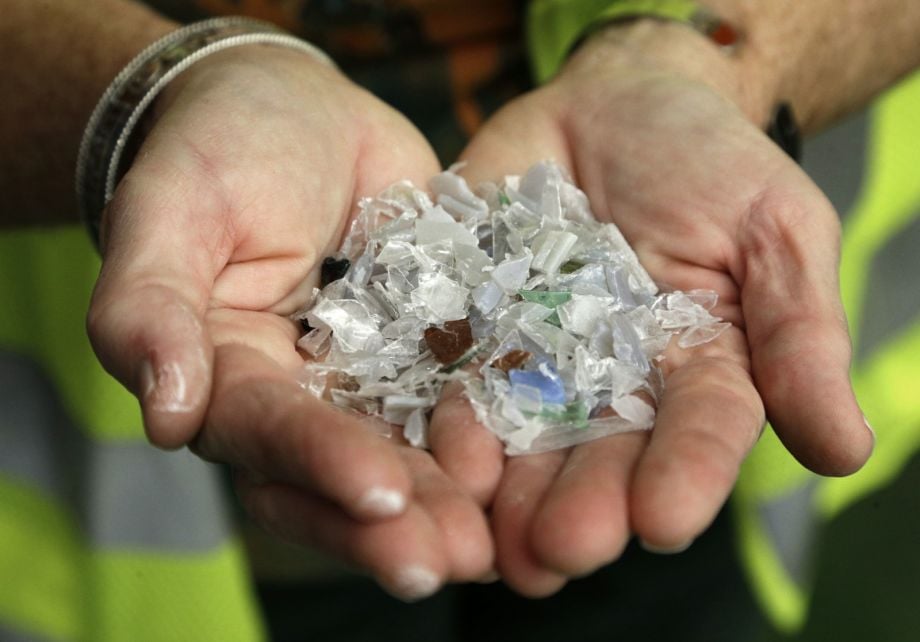
This 2016 photo shows plastics cleaned and chunked down into chips that are resold for recycled plastic. (AP Photo/Chuck Burton)
In Portland, Oregon, the numbers break out in recycling’s favor, although the difference is slimmer. Bruce Walker, who supervises that city’s solid waste and recycling program, says recycling costs the city between $90 and $105 per ton, while garbage costs $97.45 per ton. Meanwhile, composting yard debris and food scraps at an average cost of $67.08 nets the city the largest savings.
So where does the market stand? Is recycling on the rocks, or poised to go bigger? How have cities addressed the constriction of the China market, and what have they done to improve the quality and frequency of their recycling programs?
With apologies to Mark Twain, predictions of the demise of recycling in the U.S. certainly look premature. At the same time, municipal programs across the country are still deep in triage mode after 12 months of upheaval.
News of rebounding demand contrasts with well-publicized financial woes a number of municipal recycling programs have suffered. Fort Worth entered 2018 having reaped almost $1 million in annual revenues from recycling over the preceding 12 months. Yet by mid-year it projected a nearly $500,000 loss for 2018 and a $1.6 million loss for 2019. San Diego brought in $4 million in 2017, and then braced for a $1.1 million outlay to pay for recycling in 2018. Also in 2018, Philadelphia balked when Republic Services, the company that collected the city’s recycling, wanted to hike the fees it charged for recyclables from $16 to $170 per ton as part of a new contract. The city rejected that offer, but ultimately negotiated a deal with Waste Management to handle half of Philadelphia’s intake at $78 per ton, with the remainder to be incinerated.
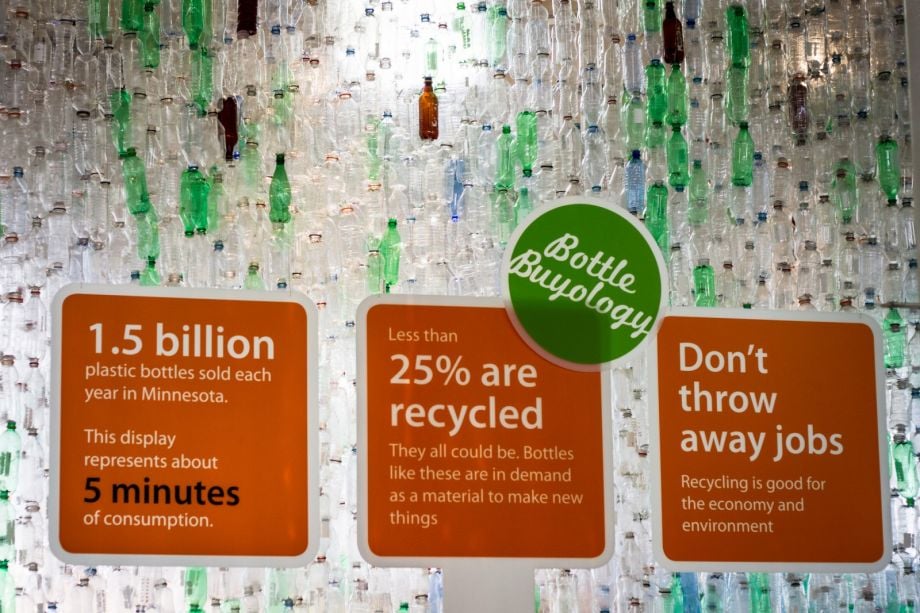
A 2012 exhibit at the Minnesota State Fair, in St. Paul, puts statewide numbers to our overwhelming reliance on plastics. (Photo by Tony Webster via Flickr)
And then there’s Portland, Oregon, a city whose recycling program is held out as a model for the country. In 2017, for instance, the city’s waste collections totaled 1.1 million tons; recycling removed 431,000 tons, or approximately 40 percent, out of the stream, while composting accounted for another 173,000 tons.
Early in 2018, Walker sensed an emergency because he was on the receiving end of some rather dire complaints from a chorus among the roster of 12 haulers who service the roughly 150,000 homes on the city’s recycling routes. Their message? The cost of collecting plastic and paper — the main targets of China’s crackdown — was mounting, and clamping on margins for haulers forced to hire more hands to sort out the waste that couldn’t be recycled. Lousy pricing for paper and plastic only exacerbated matters. What’s more, the processing companies, known as materials recycling facilities (MRFs), were slowing their work.
Walker says it was clear that to keep haulers out of crisis, the city had no choice but to raise the rate it charges homeowners for garbage and recycling collection, a hike that amounted to $2.55 a month. What’s more, the increase had to be rushed into effect not in June, when most hikes take effect, but as early as May — one way to stave off bankruptcy.
The Environmental Protection Agency (EPA) stayed eerily quiet during these upheavals. Not a single one of their news releases in 2017 or 2018 mentions the chaos in the global recycling market. This past November, however, the agency publicly threw what might be called renewed support behind recycling during a special summit. The event brought together 45 stakeholders, including the federal agency’s acting head, Andrew Wheeler; New York City’s Department of Sanitation; industry organizations; and even representatives from the two largest privately-held garbage collecting companies, Waste Management and Republic Services. That said, the feeling persists that recycling efforts would benefit from more centralized leadership.
Fast forward to 2019, and signs indicate that prices for some recycled materials have reached a stable floor, while others are starting to rebound slightly. According to Resource Recycling, the price for corrugated cardboard has hovered around $70 a ton since mid-2018, although it traded at $100 a year ago and $180 in July 2017. PET, the plastic in beverage bottles and jars, currently stands at 15.11 cents a pound, compared to 13.76 cents a year ago.
Even with the sense that market turbulence is settling down, one fact remains clear. “China’s not coming back like before,” says Cody Marshall, project manager for the Recycling Partnership, a nonprofit that help cities improve their recycling efforts. “The message is that going forward, we have to be more self-reliant.” As Seldman asserted in an article for Governing, “… it’s an opportunity for our cities to realize the full potential of appropriate, sustainable and circular development, creating wealth from within.”
Municipal recycling programs will have to solve three critical issues to remain viable and to make the most of a rebound.
First, cities must close the yawning gap between how widespread and popular recycling programs are and just how effectively they keep reusable materials out of landfills. A 2018 Harris poll commissioned by the industry organization the Institute of Scrap Recycling Industries found that almost 80 percent of the nation has a nearby recycling program, while 89 percent of those with access found the service to be valuable.
That said, the U.S. recycling rate — a calculation of what percentage recycling programs recover out of total garbage flows — is currently 34 percent, having effectively plateaued since 2010. Compare that figure to the recycling situations in Germany, Austria, South Korea and Wales, which according to the World Economic Forum, channel 50 percent or more of their solid waste for recycling. Switzerland, Italy and Belgium are within a percentage point of that mark.
Second, cities must decrease contamination. A surprisingly large amount of stuff Americans throw into recycling bins is well, just plain garbage. Contamination rates in the U.S. current stand at 15 to 25 percent, a surprising wide estimate given the lack of centralized data collection. Put that figure into context, namely the very strict — and low — bar the Chinese government has set for contamination of imported recyclables: 0.5 percent. Botched batches of recycling are a point of contention between companies that handle, sort and move recyclables and the municipalities they serve. David Biderman, CEO of the Solid Waste Association of North America (SWANA), an industry organization for garbage and recycling collection, said at the EPA conference in November, “Maybe we should stop thinking about chasing tons and we should be going after the right tons.”
When it comes to recycling, Americans are happy to pitch in, perhaps to an overzealous fault. The industry terms this propensity “aspirational” recycling — to throw into your bins random items that seem as if they should be recyclable. Denver’s head of solid waste management, Charlotte Pitt, says among the pieces that have made it into her city’s collection carts are an engine block, horseshoes, a garden hose and t-shirts. Given to peeking in recycling bins at train stations and airports during his business travels, Biderman has seen horrors including a bowling ball and dirty diapers. The irony is that his same informal inspections turn up generous heaps of aluminum cans, plastic bottles and paper that have been tossed in the general garbage instead of the proper receptacles.
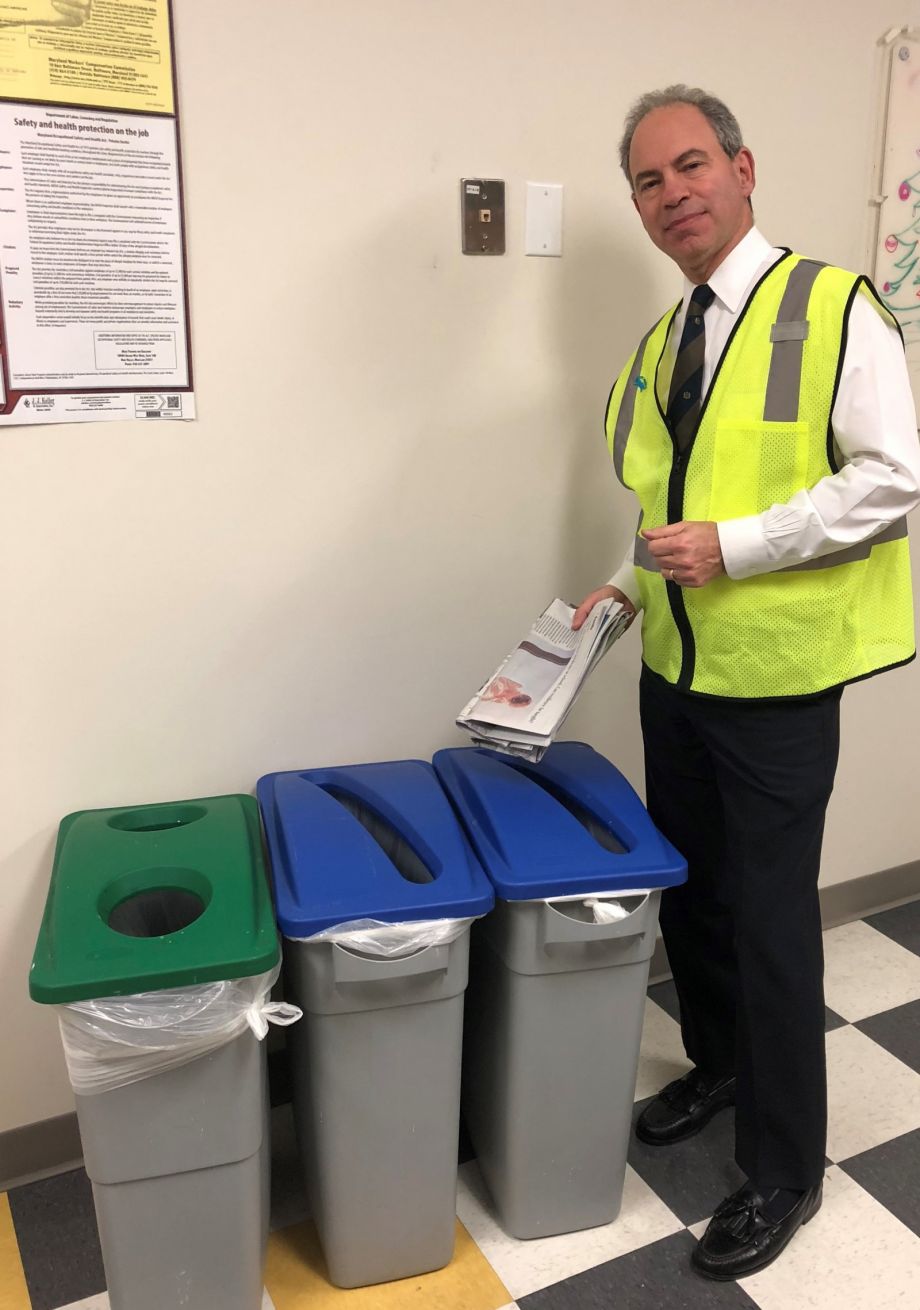
David Biderman, CEO of the Solid Waste Association of North America, routinely checks bins on his travels to see how compliant folks are with their recycling.
Third, the recycling business must prepare itself more effectively for rollercoaster market conditions. The industry’s fortunes, after all, are anchored to the boom-and-bust cycles of commodity markets — in this case, recycled paper, plastic and glass — with up and down swings in supplies, demand and ultimately pricing. And a number of recent economic events have triggered troughs. In 2000, it was the Asian contagion financial crisis. In the early 2010s, when oil prices plunged during the fracking boom, so did the cost of making new plastic, as manufacturers moved away from using recycled feedstock
Seldman says the current price swoon has exposed inefficient business models for some recyclables such as glass. At issue, he says, are the contracts the garbage hauling industry has struck with cities — contracts that sometimes stipulate that recyclables have to be transported at an additional cost to a facility servicing a broader area. The upshot? With that additional cost, recycling glass and some other products become simply unviable.
There are positives in sight. Groups are coaching cities on ways to reach more residents with clearer messages. Efforts are underway to cut contamination in recycling streams. And finally, there may be an incentive now for municipalities to keep the processing of recyclables local.
Messaging and education are twin solutions to boost the amount of material that’s correctly recycled. This effort is hampered by no centralized, coordinated effort on the part of a government agency such as the EPA. One example, according to Waste Dive, an online publication that tracks the industry, is the lack of an industry consensus on just how to measure the success of recycling efforts: Private collection companies and municipal waste services departments still struggle over whether the best metric to track the amount of recyclable material diverted out of nationwide trash flows should be raw tonnage recycled, or the net effect to greenhouse gasses, the latter based on inputs such as participation rates and recycling collections calculated with a formula to estimate CO2 offsets. The argument is that even if hypothetical, the greenhouse-gas numbers might shed more light on the environmental value of each facet of a municipal program — and provide a meaningful public-relations yardstick to boot.
In such a data-analysis vacuum, nonprofits take up the slack. Recycle Across America has pushed for standardized labels for bins nationwide and boasts a case study across Rhode Island that helped to bring contamination rates down 20 percent. And the Recycling Partnership this week launched its program to help cities measure the full impact of recycling efforts, including a greenhouse gas calculator on the organization’s website. The nonprofit is backed by private-sector funding partners, including companies who rely on paper and plastic packaging such as Amazon, Starbucks, Target and International Paper. Marshall says the group handed out grants totaling $40 million last year, primarily targeting collection efforts where he says communities spend the majority of recycling funds. In four years leading up to 2017, for instance, it provided funding to purchase 182,000 curbside carts and helped 583 communities.
Starting in 2016, the Recycling Partnership reached out to municipal garbage and public works managers across the country to understand what was at the root of persistent contamination problems. Three cities provided interesting case studies. Recycling programs in Chicago and Atlanta turned up high percentages of the wrong type of trash. Denver, meanwhile, had low contamination levels, but needed to step up participation to boost the city’s recycling rate of 18 percent. “We had some big, dynamic ideas, so we decided to partner with all three cities at the same time,” says Marshall.
The nonprofit contacted public works or sanitation departments in all three cities to propose a series of exploratory interventions that Marshall characterized as “tactical messaging” — a campaign anchored to one specific message for each city. In Atlanta, the primary focus was simple: too many residents were putting recyclables in plastic garbage bags, which polluted collections. The campaign slogan became, “Don’t bag your recyclables.” In Chicago, the message was: “Don’t put plastic wrap in your recycling cart.” Denver’s effort, meanwhile, encouraged residents to recycle more aluminum beverage cans.
Step one was to spread the word with mailings, social media posts and printed tags attached directly to recycling carts. Recycling Partnership directors, meanwhile, conducted seminars and training sessions in each of the three cities to teach employees — garbage route drivers in Chicago and public works employees in Atlanta and Denver — how to track collections on the ground, going as far as opening cart lids and taking note of what was turning up.
That observe-and-record system was put to the test over the next eight recycling collections. In Chicago, for instance, drivers tagged carts filled with trash that was not in line with recycling guidelines. In Denver and Atlanta, teams of city employees snooped in bins before garbage collectors arrived. Their mission: Affix tags where they saw violations — this was not only a message to sanitation employees to skip a specific bin, but a way to bring residents up to speed on the rules.
At the same time, the Recycling Partnership recommends graduated soft reprimands (instead of fines) for households or residents who dump unacceptable garbage in recycling receptacles. Violators who toss sheetrock, plastic bags or garbage in recycling carts get a warning — a tag to make it clear why their container was refused. Two violations can result in a resident’s cart being confiscated.
The Partnership says the work is delivering tangible results. In Chicago, efforts reached 630,000 households and garnered 2.7 million social media views. Most importantly, the city reported a 32 percent drop in recycling contamination rates. The Atlanta drive registered a 62 percent drop in erroneously bagged recyclables, and close to a 60 percent drop in contamination overall.
Denver’s Pitt says the city’s work with the Recycling Partnership is paying off. She points to the city’s climbing recycling rate as evidence, a figure she estimates has risen approximately five percentage points to its current level between 23 and 24 percent.
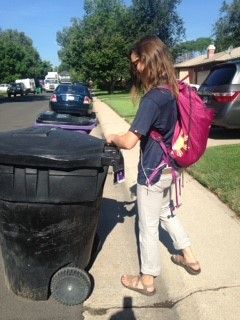
A representative from Denver's solid waste management team inspects and tags some recycling bins for non-compliance.
Denver turned to the nonprofit for help as it rolled out plans to expand recycling efforts. Beginning in 2005, the city switched to a single-stream program to collect newspaper, cans, bottles and some plastics in a single cart per household. The catch was that residents had to call in to request a bin to regularly set out for collection. That resulted in 40 percent of city opting into recycling efforts — a low number of committed participants who nevertheless seemed to stick to guidelines, as evidenced by an exemplary contamination rate that remains just under 10 percent, according to Pitt.
Two years ago, Denver began delivering carts to every home that had yet to formally sign on. While the original plan was to distribute the carts over a five-year period, the city is far ahead of schedule and will hand out a final 178,000 this coming month.
Pitt’s department signed on for a pilot with the Recycling Partnership in 2017, starting with a direct-mail campaign and informational tags on trash carts that explained the program and just what types of refuse could be recycled. Four members of Denver’s solid waste department’s education team joined forces with artists and the nonprofit’s marketing experts. Ads were put on the city’s fleet of 120 collection trucks, while the campaign took a dive into social media, including Facebook and Twitter. “It was a joint effort,” says Pitt, “We checked to see if the message would resonate and the advice we received was to keep things simple.”
Follow-up included briefing sanitation department drivers who covered recycling routes on what cart contents belonged, and what should be turned down. Trucks were equipped with video cameras to monitor what was included. Drivers were asked to stay in radio contact with the public works department’s customer service department and team supervisors were charged with either knocking on doors and speaking to residents about blatant problems or making notes in a database to address the problem by tagging a cart or removing it.
Pitt reports that the impact on Denver of the global recycling market upheaval was relatively muted. The city has a contract with a local processor, Alpine Waste & Recycling, which takes in collections, sorts them and then sells what passes muster. Alpine invested $5 million in upgrades to its sorting abilities in the Denver plant, which has helped to keep the entire process local and eliminate prohibitive transportation costs. The city makes up roughly a fourth of Alpine’s business, estimates Pitt.
Denver keeps tabs on contamination a couple of ways. Pitt says her department conducts random sampling of collections and works with a consultant to conduct an analysis of the city’s waste stream. Alpine, at the same time, audits loads and alerts Pitt’s group if collections from some routes are particularly contaminated. That signals the public works department to step up cart tagging and other outreach efforts.
Contamination levels, nevertheless, remain a sore spot for recycling efforts nationwide, a problem that China’s new standards have only magnified. Denver’s current contract with Alpine, for instance, gives the processor the right to refuse loads with an estimated 25 percent contamination level. In Norfolk, Virginia, TFC Recycling, an MRF, opted out of its city contract in August 2018, citing an inability to fully process much of what it collected.
Processing recycling collections that include the wrong things (such as plastic bags) cause a host of other problems as well. “The recycling facilities have to pay to get [contaminated waste] to a landfill, and there are operational costs associated with processing that material that’s costly,” says SWANA’s Biderman. “So, they’re using up some of their operational capacity to process material that’s not recyclable, and paying about $55 a ton to dispose of it in landfills.”
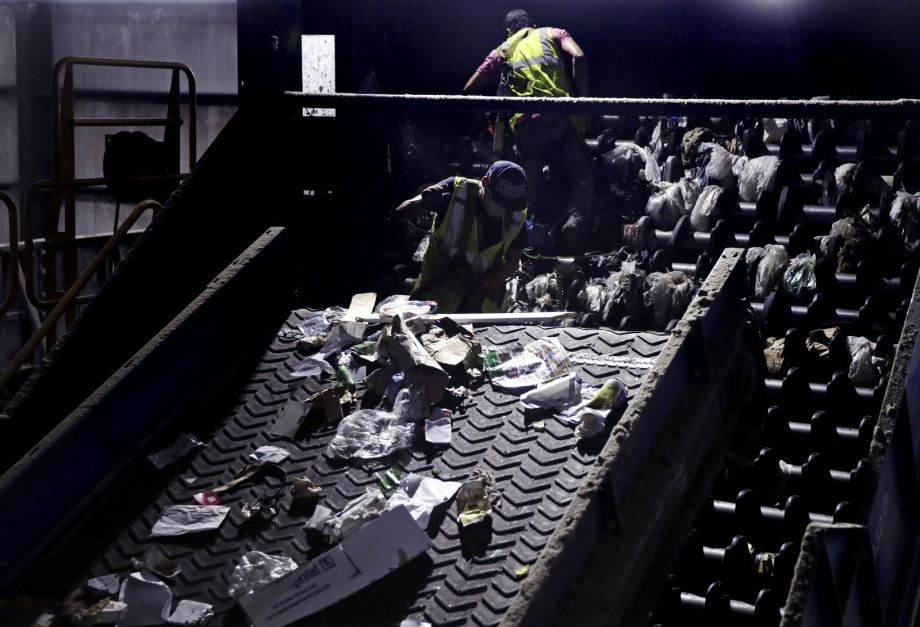
In this 2018 photo, workers clean consumer plastic shopping bags from the clogged rollers of a machine which separates paper, plastic and metal recyclable material, at a Westborough, Massachusetts, sorting facility. Unrecyclable plastic bags are a major source of contamination. (AP Photo/Charles Krupa)
One source of the problem lies in how many different bins the local sanitation department chooses to service. In the name of ease and simplicity, most cities – approximately 80 percent of recycling programs nationwide — now opt for single-stream collections, where residents deposit paper, plastic, and other materials into one bin or cart. During the past decade, in fact, many cities have migrated to single-stream rather than dual-stream collections (in dual-stream, typically participants are required to separate paper from plastics and metal).
The upside for single-stream is that it boosts volumes. The problem is that commingled contributions to single-stream programs lead to far higher contamination rates.
Education efforts such as those spurred by the Recycling Partnership help. But interestingly enough, the past year’s market turbulence may spur a new trend. Case in point: Last November, the Long Island communities of Brookhaven, Smithtown and Southold, New York (a combined population of 625,000) switched to a dual-stream collection.
That kind of approach puts the industry in a quandary, especially since MRF’s have spent hundreds of millions on scanning equipment and infrastructure to accommodate single-stream systems. “You generally don’t get as much material in dual-stream systems,” says Biderman. “Large companies will tell you that the single-stream ship has sailed. We can’t turn back the clock and strand that sort of investment.”
ILSR’s Seldman says the past year’s shakeup also calls into question key cost assumptions built into the way many cities recycle. The current pricing squeeze shines a light on the price of working with Big Waste — large garbage collection companies such as Waste Management and Republic Services. One considerable cost is the transportation to move recyclables to centralized processing sites. Seldman estimates that can run $15 to $18 a ton, an amount that could tack on $450,000 or more a year for a city such as Washington, D.C.
Take Baltimore as another example, which pays $83 a ton for moving recyclables at a Waste Management facility, says Seldman. Washington, D.C., which he says uses the same location, pays $129 a ton, in addition to a $25 surcharge for glass. Based on that math, he says D.C. is being charged more than $40 a ton more — a considerable sum considering the 30,000 tons of recycling it has to move.
That added burden potentially puts cities in a bind when it comes to glass, arguably the heaviest recyclable commodity. Weak pricing and high costs have worked in tandem to discourage municipalities from collecting it. One answer to bring down transport costs and make a wider array of items such as glass viable, says Seldman, is to promote or sponsor more local MRF’s to enter the market with a lower cost basis.
Another solution that betters both contamination and participation is to employ unit pricing, or assessing a monthly fee for household disposal. A study of communities in Southern Maine performed by WasteZero, an environmental sustainability advocacy group, found that during 2017, communities with pay-as-you-throw collection models disposed of almost 45 percent less non-recyclable trash than others examined. What’s more, the pay-as-you throw group averaged a 33.1 percent recycling rate, compared to 20.4 percent in the other communities the study examined.
Seldman says there’s evidence that charging residents according to how much garbage they generate is one reason why cities such as Portland boast higher recovery rates — including recycling and the diversion of compost from waste streams — than Baltimore, Washington or Dallas, which are all under 20 percent, well below the nationwide average of 34 percent.
Though contamination and consumer education remain challenges, SWANA’s Biderman takes heart, especially in the aftermath of November’s EPA gathering, which presented an opportunity to headcount (and connect) stakeholders. “We’ve got communities talking to each other about common recycling problems, we’ve got stakeholders throughout the recycling supply chain working together to address the challenges posed by China’s waste restrictions, and we have increased investment in U.S. domestic recycling capacity — including both U.S. and Chinese companies purchasing paper mills and plastic processing facilities here,” he says. “That’s why I’m cautiously optimistic.”
Thanks to Aline Reynolds for contributing additional reporting to this story.
EDITOR’S NOTE: The original version of this article incorrectly described the U.S. recycling rate as having peaked 20 years ago, when it has effectively plateaued since 2010. It also misstated the number of tons of recycling that Washington, D.C., generates. We’ve corrected these figures.

James A. Anderson is an English professor at the Lehman College (Bronx) campus of the City University of New York.

20th Anniversary Solutions of the Year magazine